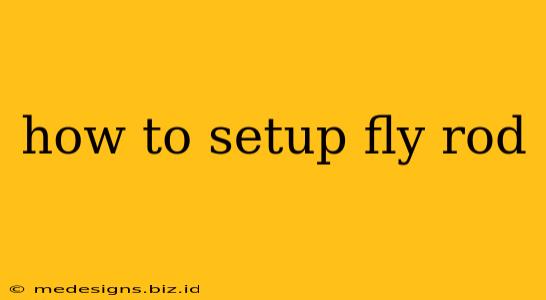How to Set Up a Fly Rod: A Beginner's Guide
Setting up a fly rod might seem daunting at first, but with a little practice, it becomes second nature. This guide breaks down the process step-by-step, ensuring you're ready to cast and fish in no time. We'll cover everything from assembling the rod to attaching the leader and fly.
1. Assembling the Rod
The first step is assembling your fly rod. Most fly rods are comprised of several sections. Typically, you'll find a butt section (the thickest part), a mid-section, and a tip section (the thinnest part). Some rods have even more sections.
-
Identify the sections: Carefully examine your rod case to identify the different rod sections. They're usually clearly marked or color-coded.
-
Insert the sections: Starting with the butt section, gently insert the next section until you feel a firm connection. Avoid forcing the sections together; a snug fit is key.
-
Repeat the process: Continue inserting the sections until your rod is fully assembled. You should feel a solid connection between each piece, ensuring the rod is secure and aligned. Make sure each section is fully seated.
2. Attaching the Reel
Your fly reel is the heart of your setup, holding the fly line and backing. Here's how to attach it:
-
Locate the reel seat: The reel seat is the area on the butt section of your rod where the reel attaches. It will likely have a clamping mechanism, usually a screw or locking ring.
-
Secure the reel: Place the reel onto the reel seat, ensuring it's oriented correctly (the handle should be facing the direction you will cast). Tighten the clamping mechanism firmly, but avoid over-tightening to prevent damage.
3. Attaching the Fly Line
Now that the reel is in place, it's time to add your fly line.
-
Removing the Reel Case: Carefully open your reel and remove the case and backing if present.
-
Attaching the line to the Reel: If the line hasn't already been spooled, follow the manufacturer's instructions to ensure proper line placement on the reel.
-
Attaching the line to the rod: The fly line should be connected to the reel via a backing. Then, you'll feed line through the guides along the rod.
4. Attaching the Leader and Fly
The leader is a tapered length of monofilament that connects your fly line to the fly. It provides a more delicate presentation and helps with casting.
-
Attaching the Leader: Using a leader knot such as a nail knot or improved clinch knot, attach the leader to the end of your fly line. The leader should be approximately 7.5-9 feet long, but this can vary depending on your fishing conditions and preferred technique.
-
Attaching the Fly: Using a suitable fly fishing knot (like a clinch knot), attach your chosen fly to the end of the leader. Make sure the knot is secure and won't easily slip.
5. Inspecting your Setup
Before heading to the water, take a moment to inspect your setup:
- Rod Sections: Ensure all sections are firmly connected and that there are no loose parts.
- Reel Secureness: Double-check that your reel is securely fastened to the reel seat.
- Line and Leader: Verify that your line and leader are properly attached and have no tangles.
- Fly: Make sure your fly is securely attached and ready for casting.
By following these steps, you'll have your fly rod correctly set up and be ready to enjoy the thrill of fly fishing. Remember, practice makes perfect, so spend some time practicing your casting before you head out to your favorite fishing spot! Practice casting in an open area to get comfortable with your gear. Happy fishing!
